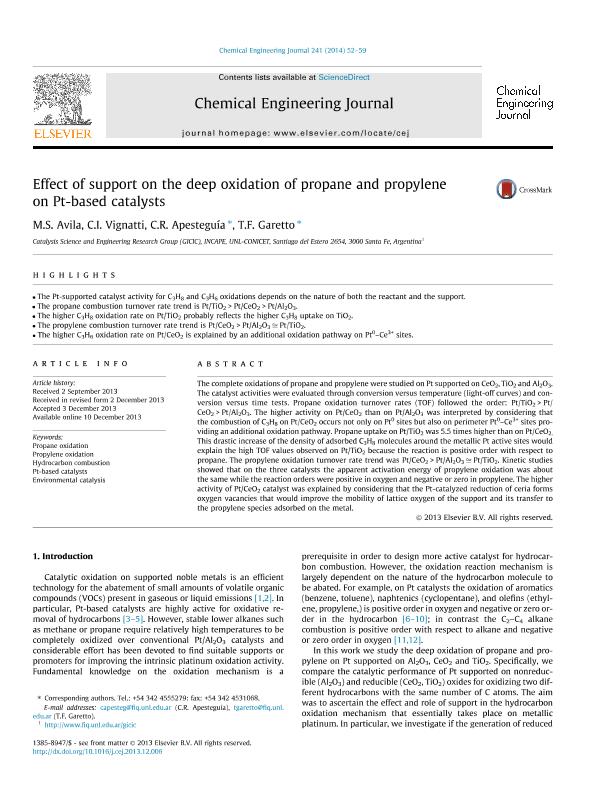Artículo
Effect of support on the deep oxidation of propane and propylene on Pt-based catalysts
Avila, Maria Sol ; Vignatti, Charito Ivana
; Vignatti, Charito Ivana ; Apesteguia, Carlos Rodolfo
; Apesteguia, Carlos Rodolfo ; Garetto, Teresita Francisca
; Garetto, Teresita Francisca
 ; Vignatti, Charito Ivana
; Vignatti, Charito Ivana ; Apesteguia, Carlos Rodolfo
; Apesteguia, Carlos Rodolfo ; Garetto, Teresita Francisca
; Garetto, Teresita Francisca
Fecha de publicación:
12/2013
Editorial:
Elsevier
Revista:
Chemical Engineering Journal
ISSN:
1385-8947
Idioma:
Inglés
Tipo de recurso:
Artículo publicado
Clasificación temática:
Resumen
The complete oxidations of propane and propylene were studied on Pt supported on CeO2, TiO2 and Al2O3. The catalyst activities were evaluated through conversion versus temperature (light-off curves) and conversion versus time tests. Propane oxidation turnover rates (TOF) followed the order: Pt/TiO2 > Pt/CeO2 > Pt/Al2O3. The higher activity on Pt/CeO2 than on Pt/Al2O3 was interpreted by considering that the combustion of C3H8 on Pt/CeO2 occurs not only on Pt0 sites but also on perimeter Pt0–Ce3+ sites providing an additional oxidation pathway. Propane uptake on Pt/TiO2 was 5.5 times higher than on Pt/CeO2. This drastic increase of the density of adsorbed C3H8 molecules around the metallic Pt active sites would explain the high TOF values observed on Pt/TiO2 because the reaction is positive order with respect to propane. The propylene oxidation turnover rate trend was Pt/CeO2 > Pt/Al2O3 ≅ Pt/TiO2. Kinetic studies showed that on the three catalysts the apparent activation energy of propylene oxidation was about the same while the reaction orders were positive in oxygen and negative or zero in propylene. The higher activity of Pt/CeO2 catalyst was explained by considering that the Pt-catalyzed reduction of ceria forms oxygen vacancies that would improve the mobility of lattice oxygen of the support and its transfer to the propylene species adsorbed on the metal.
Archivos asociados
Licencia
Identificadores
Colecciones
Articulos(INCAPE)
Articulos de INST.DE INVEST.EN CATALISIS Y PETROQUIMICA "ING. JOSE MIGUEL PARERA"
Articulos de INST.DE INVEST.EN CATALISIS Y PETROQUIMICA "ING. JOSE MIGUEL PARERA"
Citación
Garetto, Teresita Francisca; Apesteguia, Carlos Rodolfo; Vignatti, Charito Ivana; Avila, Maria Sol; Effect of support on the deep oxidation of propane and propylene on Pt-based catalysts; Elsevier; Chemical Engineering Journal; 241; 12-2013; 52-59
Compartir
Altmétricas



